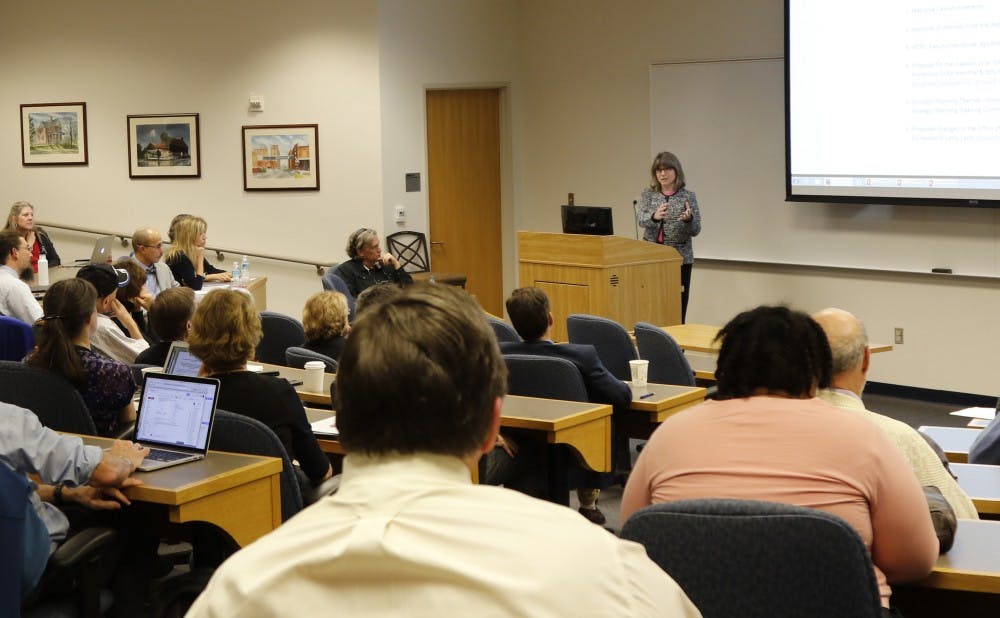The Strategic Planning Steering Committee is in the process of setting a new path forward for the University.
Provost Sally Kornbluth sent an email to all students Nov. 19 with a six-page document outlining four goals for the University and its graduate and professional schools. The goals include “bolstering intellectual communities,” increasing diversity, connecting global and local involvement and leadership and supporting Duke faculty. According to the document, the goals represent possible areas of emphasis for Duke’s next strategic plan, which will define and explain the University’s long-term goals.
Since January, the Strategic Planning Steering Committee has been having conversations with faculty and students. This past summer it wrote the framing document which was released in November. During the next several months the office of the provost and the committee will continue to invite and collect feedback and work on developing a more specific plan, which is scheduled to come out next fall and be approved by the Board of Trustees in February 2017.
The two most recent strategic plans include “Making a Difference” and “Building on Excellence”, which were published in 2006 and 2001 respectively.
Susan Lozier, chair of the steering committee and Ronie-Richelle Garcia-Johnson Professor of ocean sciences, has been working at Duke for 23 years.
“I’ve been at Duke since 1992, and almost from the very beginning have been very involved in university issues,” Lozier said. “So I teach and do research, but I’ve seen the changes over these past 23 years. And Duke has made remarkable strides. I’m an oceanographer but I’m very interested in history. ... Sometimes looking at the past makes you interested in the present. You get a real sense of ‘things can change.’”
The committee began with a sense that Duke needed to continue to improve in connecting student activities to academics and in improving diversity, particularly faculty diversity, Lozier explained.
“We recognized that we’ve made great strides in creating a more diverse student population, both undergraduate and professional/graduate, but we really need to work a lot more on making it a more inclusive environment,” Lozier said. “The pace of diversifying the faculty hasn’t kept pace with the students.”
Lozier said the two goals that came mostly out of student and faculty conversations were the goals of deepening local involvement and developing more programs for graduate students. Duke has more graduate students than undergraduates, Lozier said, but “a lot of that innovation that we’ve had for our educational programs has been primarily focused on undergraduates.”
The framing document discusses the possibility of an increased focus on opportunities for graduate students as part of a goal to expand “intellectual communities” at Duke. This could include increasing collaboration between undergraduate and graduate students as well as opening up opportunities currently only available to merit scholarship students.
Students and faculty also expressed a desire for increased engagement and involvement with communities around Duke, Lozier noted.
“The other thing that really emerged is a very strong interest in engaging with our local community—meaning Durham, the Piedmont and the Southeast, and thinking about how the research at Duke can be amplified and enriched by what’s going on at other universities here, what’s going on in nonprofits and in governance,” Lozier said. “We’ve had strong really innovative programs globally, but we also want to think about what we can do locally—moving beyond community service engagement and thinking more about how Duke’s research can play a role.”
Lozier will continue to play a large role in the process as chair of the steering committee. She explained that the committee will now consider how the University might implement some of the goals listed in the framing document.
“The greatest challenge right now is that the framing document really listed aspirational goals, so the challenge right now is what do we do to meet those goals.” Lozier said. “We said to people ‘Where should Duke be? What kind of university should Duke be in 10 years?’ ... We’re having more meetings and talking to people... we’re just thinking about what we want to do to get there.”
Get The Chronicle straight to your inbox
Signup for our weekly newsletter. Cancel at any time.

